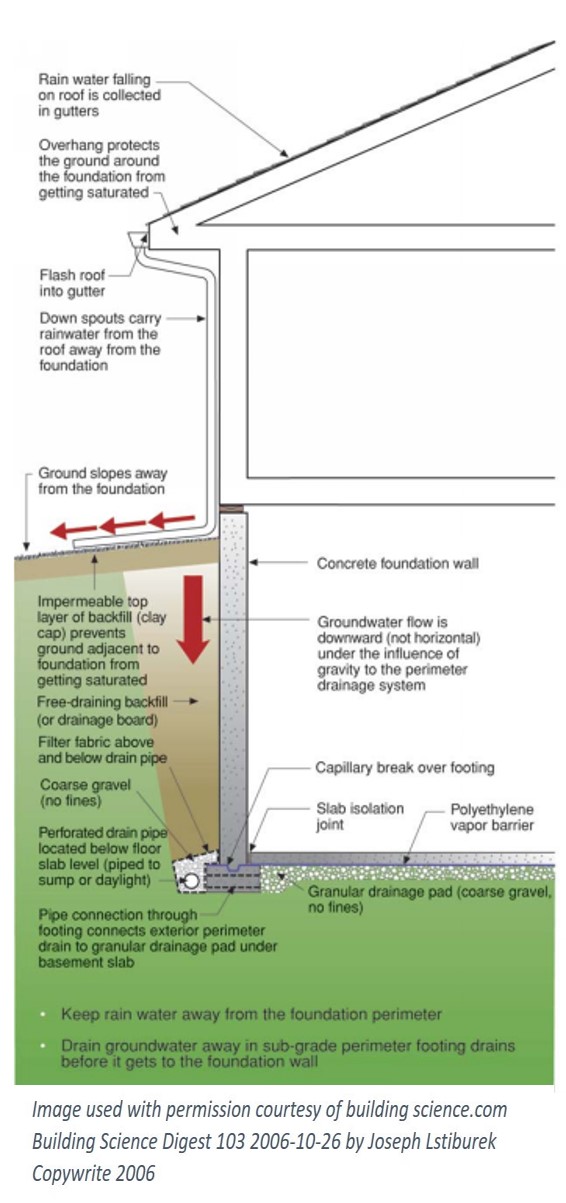If a house has a basement water problem, digging around the foundation, which can be an expensive and back breaking undertaking, is not necessarily a required first step to diagnosing the problem. In an existing home, how the foundation perimeter was completed is not always known. Acquiring the “as built” plans of the home from the town is a good idea and plans are typically available from the town office. The “as built” plans typically show what the builder ultimately completed on the property.
The fundamentals of groundwater control around basements focus primarily on “drain the site and drain the ground”. This means managing water run-off from the roof and building using gutters, downspouts, downspout extensions, or downspouts that connect directly to a stormwater management system. In addition, ensuring the grade around the foundation slopes away and not toward the foundation is essential and effective. Additional best practices include ensuring the backfill around the foundation has a combination of an impermeable layer just under the topsoil and then a free draining backfill or drainage board to direct water to footing drains which may drain to daylight or to a stormwater drainage system. The aim is to not saturate the ground next to the foundation.
As noted above, if you have water in your basement, first try some of these fixes:
- Do you have gutters and are they clear of leaves and sticks? To determine if a gutter is plugged, check the downspouts during a rain event. If there is no water running from them or water is draining very slowly, they are probably plugged. If you feel safe climbing a ladder, look inside the gutters and downspouts and clean them. You can also hire a contractor specializing in inspecting and cleaning gutters.
- Add gutter extensions at the end of the downspouts. The gutter downspouts should be made to discharge ten to fifteen feet away from the house to minimize “short circuits” of water back into the basement.
- Is the ground around the basement sloped away or toward the house? In general, water should flow positively away from the house. Your aim is to have about one inch drop for each foot away from the basement foundation for at least 10 feet. If you do regrade, be careful, you don’t want to bring the soil too close to the top of the foundation where the wood structure begins. Aim to have at least a 6-inch gap between the top of the soil and the top of the foundation wall.
If water is still entering the basement, try these next steps:
- If water is coming up low on the foundation or floor, the footing drains may be plugged. If you have footing drains there is usually a clean-out in the basement. Find it and then hire a plumber to clean it out.
- Install a perimeter drain around the exterior of the foundation. Often called a Curtain Drain, this system uses a perforated pipe to capture water underground and direct it away from the house. Dig a trench around the foundation about two feet deep and wide. Fill the trench with about three inches of washed stone gravel, lay landscaping fabric on top of the gravel leaving enough fabric to wrap the pipe. Lay the pipe on top of the fabric and cover the pipe with additional washed stone gravel. Wrap this top layer with the fabric, add sand on top of the fabric, then add your topsoil and turf. Aim to have about five inches of sand and topsoil above the top layer of fabric. Add a bed of stone around the open end of the drain pipe.
- Another option is to add a sump pump. You could also consider waterproofing the outside of the foundation walls. You would need to hire a professional to complete those tasks.
When it comes to basements, there are no guarantees these will fix water entry, but most times they do, and many times without a big expense. The key is methodically stepping thru these options to determine if the condition improves. A basement that has been dry for years may suddenly suffer from water intrusion as the ground settles around the foundation. Monitoring and maintaining gutters, downspouts and extensions are always the best first steps, but if water intrusion becomes an issue anyway, you have options. Don’t get frustrated, get working!
Give us a call if you are not sure how to proceed. An opinion by a Professional Engineer may save you a lot of time and money. We can be reached at 802-747-4535.
Criterium-Lalancette & Dudka Engineers, Copyright ©2019
